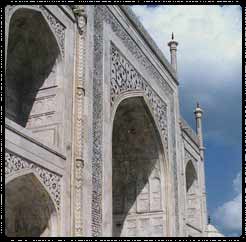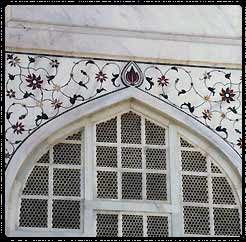|
|
 The
Taj Mahal (Crown Palace) is India's most famous structure, and, perhaps
the most beautiful piece of architecture in the world. Photographs
cannot truly capture the grandeur of this perfectly proportioned tomb of
Mumtaz Mahal and its creator, Shah Jahan, the fifth Mughal ruler.
The
Taj Mahal (Crown Palace) is India's most famous structure, and, perhaps
the most beautiful piece of architecture in the world. Photographs
cannot truly capture the grandeur of this perfectly proportioned tomb of
Mumtaz Mahal and its creator, Shah Jahan, the fifth Mughal ruler. Mumtaz Mahal was the second, and favorite, wife of Shah Jahan (r. 1628-1658). A Persian princess born as Arjuman Banu Begum, she was a significant influence in his life and in his policies. She died at age thirty-nine while giving birth to their fourteenth (some say thirteenth) child in 1631. The ruler went into deep mourning and much of his empire was compelled to do the same.
Almost immediately there was announced a competition for plans to construct a tomb and shrine worthy of the ruler's beloved. Numerous legends surround the selection of the architect--some even implausibly suggesting that it was a westerner from Italy or France. But although a number of names have been proposed, the architect's name is unknown. It is clear that talent from many parts of the Muslim and western worlds came together in Agra to work on the mausoleum: engineers, carvers, artists, calligraphers, architects, craftsmen of all sorts, and a variety of common laborers. It is estimated that 20,000 people worked on the tomb from 1631 to 1648. Work continued in the adjoining areas until 1653. It should be noted that the Taj Mahal is a total package of tomb, mosque, gardens, gateways and fountains.
The Taj Mahal is set on a raised platform that is 6.6 meters (20 ft) high and covers an area of 93.9 sq. meters (313 sq ft). The corner minarets are 41.1 meters (137 ft) high. The main structure is 62 meters (186 ft) on each side. In contast to the gleaming white marble of the mausoleum, there is a pair of red sandstone buildings flanking the tomb to the west and to the east; the western building is a mosque, while the other, sometimes called the guest house or museum, was built to complete the symmetry of the scene. The water causeway and fountains beautifully join the gateway and the tomb in perfect symmetry.
 There
are numerous significant and striking elements in the creation of this
masterpiece both inside the taj mahal as well as outside. The
marvelously graceful piedra dura (or stone inlay work) that Adorns many
surfaces. This ncludes the three major elements of the Muslim decorative
arts: the sayings from the Q'uran, geometrical shapes and a variety of
plant forms and flowers, often repeated as borders. The marble and
precious stone inlays are so skillfully fit together that one can hardly
detect a seam, even with close examination. The calligraphy of sayings
from the Q'uran on the mausoleum, are in a kind of trompe l'oeil style;
the letters gradually increase in size as they go up the side of the
structure, so that from the ground all letters appear perfectly uniform.
Perhaps, however, the greatest impact is how all of its parts fit
together so perfectly, making the entire complex much greater than the
sum of its parts.
There
are numerous significant and striking elements in the creation of this
masterpiece both inside the taj mahal as well as outside. The
marvelously graceful piedra dura (or stone inlay work) that Adorns many
surfaces. This ncludes the three major elements of the Muslim decorative
arts: the sayings from the Q'uran, geometrical shapes and a variety of
plant forms and flowers, often repeated as borders. The marble and
precious stone inlays are so skillfully fit together that one can hardly
detect a seam, even with close examination. The calligraphy of sayings
from the Q'uran on the mausoleum, are in a kind of trompe l'oeil style;
the letters gradually increase in size as they go up the side of the
structure, so that from the ground all letters appear perfectly uniform.
Perhaps, however, the greatest impact is how all of its parts fit
together so perfectly, making the entire complex much greater than the
sum of its parts. In recent years, this great manument is fighting a strange battle - battle with increasing pollution of the area. Several measures have been taken and several projects are under operations to save the world's supreme architectural achievement.


